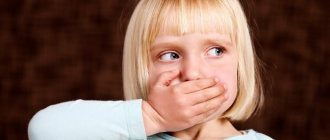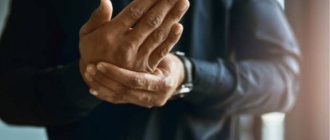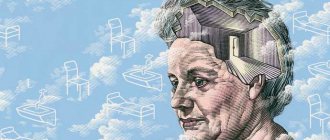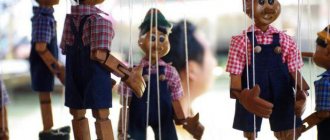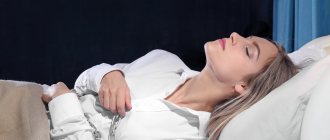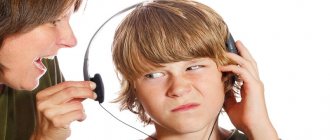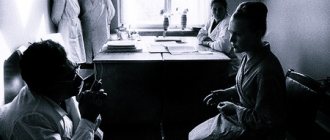If you feel disgust and fear at the sight of a honeycomb or mushroom sponge, you have trypophobia.
Although, in fact, not everything is so simple. Let's figure it out.
The term trypophobia, or fear of cluster holes, comes from the Greek trypa, or hole. Fear arises in people suffering from this condition the moment they see something covered with small holes arranged in an asymmetrical pattern.
Some people mistakenly believe that trypophobia is a new disease. That such a disease did not exist before. This is not entirely true.
Indeed, “trypophobia in pictures” dates back to 2005. The growth of the disease was facilitated by the rapid development of digital photography, when everyone had the opportunity to take a large photo of an orange peel or coral. Plus, the rapid development of various 3D technologies added fuel to the fire.
Today, you don’t have to be a professional photographer or artist to quickly and easily create an image that causes trypophobic horror in many people.
Especially popular among those who want to be scared are colorful photos of human skin covered with trypophobic patterns. It might look something like this.
Such images evoke unpleasant emotions in 30% of people. But it would be incorrect to say that all these people suffer from trypophobia. After all, images are really dangerous. Imagine that you meet a person on the street who is actually covered with holes like this. Most likely he is very seriously ill and contagious. And it carries danger. And therefore, the fear caused by such hypothetical individuals in others is not of any morbid nature.
However, 16-18% of people are driven into trypophobic horror not by photoshopped pictures of people’s skin, but by normal macro images of objects of living and inanimate nature.
These can be inhabitants of the deep sea, raw mushrooms, chicken skin, large-porous rocks and other similar objects.
So the following pictures show mushrooms, sandstone rock, coral and chicken foot skin.
In more severe forms of trypophobia, fear is caused by images of the most common foods.
Pancake batter Are you scared by chocolate? What about a piece of bread? If not, then don’t worry – you don’t have true trypophobia.
By the way, people suffering from this disease are frightened not only by pictures of holes, but also by bulges. The most terrible objects are pods, pores, and seeds.
Pea pods In the largest number of cases of trypophobia, fear arises only when looking at natural objects. Mostly alive. But some people are frightened even by artificially created art objects, even items of clothing.
On some Internet sites you can find a statement that trypophobia has only recently arisen. This is wrong.
Yes, indeed, today many more people are aware of their fear, since the development of the Internet and digital photography has allowed them to see their fear with their own eyes. However, trypophobia existed before.
Especially in that form that can be called true. The fact is that few people are afraid not only of large color photographs of pores on human skin or a mushroom cap, but also of these objects themselves in life. Without enlarging them.
That is, true trypophobia cannot look at everything that is presented in the pictures above in real life. They shudder at the sight of citrus peel, sandy rock on the beach or honeycomb.
The condition of true trypophobia can be quite severe. A person is completely deprived of the opportunity to even eat bread, since there are holes in it.
What is the fear of holes and openings called?
The concept of trypophobia itself appeared only in 2004 from the Greek “Trypo”, which means “holes” and “Phobos” - fear.” The mental disorder causes a sudden feeling of fear, discomfort and general restlessness when seeing objects with small holes, such as a honeycomb, a clump of coral or fern leaves. This uncontrolled reaction of self-protection and repulsion can cause sudden onset of nausea or dizziness. The patient associates similar holes/patterns with openings on his skin. Although this type of phobia is not yet officially recognized and some research is underway, over the past decade thousands of people have been subjected to attacks of the new disease.
Symptoms of trypophobia
Very few people have heard the term trypophobia, what it is and how it manifests itself. Even the carrier of this pathology may not know about its existence until he encounters a specific sight that will throw him out of emotional balance.
Philophobia - what kind of disease is it?
Fear of holes can manifest itself in varying degrees of emotional overtones:
- strong fear;
- cardiopalmus;
- nausea;
- numbness;
- uncontrollable panic scream;
- subsequent sleep disturbance;
- nervous excitability;
- anxiety;
- skin itching;
- dermatitis;
- headache.
Attention! A person with trypophobia should not be deliberately shown pictures that are disgusting to him for fun. Nervousness can provoke a change in consciousness, the consequences of which will have to be treated in a specialized clinic.
Symptoms appear immediately at the moment of visual contact with a cluster of multiple holes or cellular structures. With numbness caused by fear, a person cannot take his eyes off the terrifying sight and is completely immersed in his emotions. People with general mental disorders may even lose consciousness after what they see.
Interesting. Most often, trypophobia is a disease observed in a squeamish person than in a picky person.
Negative reactions limited to discomfort at the sight of many holes and fear that the holes may be infected are normal reactions. A person intuitively compares small holes on the surface of the skin with ulcers and is afraid that something similar will appear on his leg or arm. This cannot be called trypophobia, especially if such a reaction did not manifest itself from the sight of ripened lotus seeds, but from a photograph of the back of the South American frog Pipa.
Frog with holes on its back for growing tadpoles
The desire to wash your hands and face after making eye contact with a large number of small holes is already a sign of pathology, accompanied by an acute sensitivity to what you see.
Phobia fear of holes - is it a disease of the human body or a mental disorder?
Such a mental disorder, although not a direct disease of the body, inspires a constant horror of “devouring” parts of the body. The patient becomes fixated on his fears and gradually withdraws into himself, fearing the ridicule of others. Images from the Internet with some degree of disgust, along with compelling stories about a strange disease, haunt sufferers for hours and even days. The disease is dangerous because a person loses coordination of movements, and his performance decreases. Of course, there are people who consider such fear to be simply psychological curiosity.
As with other mental fears, an attack of trypophobia develops suddenly and fleetingly.
What are trypophobes afraid of, symptoms of the disease
For some, the accumulation of holes manifests itself only as disgust, while for others it becomes a real problem.
- Goose bumps indicate a self-defense mechanism when the body reacts to anxiety.
- The feeling of danger provokes the heart rate in the body. Seeing a disturbing picture, a person begins to analyze it, unable to concentrate on other things.
- Sudden loss of self-control and a growing sense of panic.
- The constant feeling of fear of holey objects becomes so great that the person seems to go crazy. Even everyday objects (oil bubbles in a frying pan or toilet paper rolls) begin to cause concern.
- Other reactions to a phobia are anger, aggression and crying. Perhaps this is due to a natural desire to destroy clusters that are sources of fear.
Common symptoms of trypophobia also include a queasy feeling in the stomach area, panic attacks, sudden and excessive sweating, actual physical illness/disgust, vomiting and dizziness. Symptoms appear when a person is close to an object that has small groups of holes or shapes with tightly packed holes. The disorder is not considered a serious or life-threatening illness, and severity varies from person to person.
What does a trypophobe feel when he sees a cluster of holes?
The reaction of people suffering from trypophobia to the sight of a cluster of holes is very intense. Manifesting itself in sudden attacks of panic, a phobia is frightening in its uncertainty. People do not know what lives inside these holes, and they are also afraid of the danger of ending up inside the figure themselves. Seeing the source of the phobia, fear provokes trembling and itching of the body, making the person physically sick. The severity of the reaction can be checked by the type of symptoms that occur when viewing photographs and objects.
These vary from person to person, but in addition to the symptoms listed above, they may include:
- hot and cold flashes;
- a feeling of suffocation, which without outside help can lead to asphyxia;
- inability to distinguish between reality and imagination;
- thoughts about death.
Causes of trypophobia
Trypophobia is considered one of the youngest phobias - they first started talking about it in 2000, and it received its name 4 years later. It is derived from the Greek words tripo (drilling holes) and phobos (fear).
It is believed that fear, or rather disgust, at the sight of clusters of holes is present to some extent in everyone. It is evolutionarily justified and embedded in the genetic memory of people, inherited by us from distant ancestors. They tended to experience a fear of animals or plants, which posed a real threat to life in those distant times.
For example, the characteristic pattern of spots on the body of predatory cats or snakes evoked a strong association with danger, which is why it began to serve as a kind of warning about it for ancient people. Over subsequent generations, a similar reaction accumulated and was passed on to modern people. However, if in the case of dangerous animals it is natural, then in other situations, when there is no real threat to life, it is considered pathological.
Another reason for the appearance of trypophobia in some individuals may be the identification of holes or their concentrations with serious infectious diseases. For squeamish and overly sensitive people, an attack of fear can be triggered by the sight of a person whose face or body has rashes, sores or scars. Defects and lesions of the skin cause such trypophobes a persistent disgust and an irresistible desire to quickly get away from what they believe is a person suffering from a contagious disease. The reason for this reflex also lies in genetic memory - our ancestors thus instinctively tried to avoid interaction with sick relatives so as not to become infected themselves.
The cause of the development of trypophobia can also be an abnormal psychological reaction, when a person, looking at the holes, imagines that something might emerge from them and harm him.
But most often the cause of the fear of holes is real cases when a person has been harmed. For example, bees may attack him and bite him. From this day on, honeycombs or any holes resembling them will cause attacks of fear and panic in such a person.
A person's age also affects whether they will develop trypophobia. According to statistics, over the years people are increasingly inclined to succumb to attacks of this phobia.
Trypophobia test - video
There are two ways to test yourself for trypophobia: by watching a video of clustered pictures and by introspecting for the presence of symptoms and signs.
You just need to be honest and watch your reactions:
- Taking a soccer ball, turn it inside out and evaluate how you feel.
- Cut the orange or melon into two halves. Look at the insides. Are there any unpleasant reactions?
- Look carefully at the picture of a honeycomb. Are there any of the listed reactions?
- Try looking at a photo of eels or a lotus flower with seeds.
- Frog eggs also cause symptoms and signs of the disorder. Try to focus on them for a while and understand how you feel.
Causes of trypophobia, who may be at risk for this disease?
Some people believe that their fear of holes is largely innate, although scientific research has linked the disorder to the environment and DNA structure.
The brain associates the presented shape with wounds, illness and danger. Other theories include:
- Fear of clustered holes may be related to evolution. When people are exposed to dangerous objects, the brain perceives them as something bad. Such reasons and experiences lie in deep childhood, when a person remembers swelling during bee stings. Fear can also be associated with certain organic objects, such as skin blisters or rashes after chickenpox and measles.
- Some researchers believe that the cause of the phobia lies in the structure or shape of DNA, which is somewhat reminiscent of holes.
- Man has instincts that help keep him safe. They are the ones who associate these shapes and patterns with danger.
- Holes and unevenness come with fear of the unknown. People suspect that something may be living or crawling out in the bulges or holes.
There are certain items that trigger bouts of the disorder.
Danger points are considered:
- bubbles;
- lotus seeds;
- grenades;
- corals;
- cantaloupe;
- foam;
- strawberry.
In addition to the above-mentioned sources, there are other mammals and insects whose mottled skin and fur are especially unpleasant to trypophobes.
The mechanics of the disorder’s impact have not been fully studied, but there is a certain group of people who are primarily at risk. 80% of people suffering from trypophobia have hereditary characteristics. Parents involuntarily pass on such fears to their children. Women are more often susceptible to the phobia of accumulation of holes than men, since their imagination is richer and their mental organization is more subtle. Family people complain more about the disorder.
Where does fear come from?
Scientists have not yet come to a consensus on what causes this phobia. 4 theories have been put forward, each of which provides its own explanation of the phenomenon:
- Biological: Our brain constantly evaluates reality to identify danger. This ability is inherent in us by nature and is called the instinct of self-preservation.
The holes themselves do not pose any threat, but, not seeing anything “positive” in them, the body classifies them as dangerous and tries to avoid them.
- Psychological: an individual may be afraid of absolutely all holes due to associations with negative experiences.
For example, he could have been bitten by bees while trying to take honeycombs from a hive, or he witnessed the following picture: trypophobia occurs as a result of psychotrauma. Interestingly, the situation itself can be repressed from memory, but the emotional memory will be triggered every time a person sees many holes. - Hereditary: This version suggests that a child whose parents (or one of them) suffers from trypophobia will also be afraid of the accumulation of holes in later life.
There is a simple explanation for this: children copy the behavior of adults, accepting as truth everything that is conveyed to them in the family. And if mom and dad demonstrate that cluster holes are scary, the offspring will fit this belief into their picture of the world. - Strong impressions can also trigger this phobia. In childhood, a child absorbs everything he sees, and if he is also suspicious (what is this?) and anxious, then a documentary about spotted frogs or an unpleasant photograph can be etched in his memory for a long time.
Subconscious fear as a self-defense mechanism
People often come up with various reasons to justify this type of psychological state. Most are inclined to think that such subconscious fear triggers an internal mechanism of self-defense and repulsion. Even familiar to the eye patterns of knitted items, honeycombs or holes in bread frighten trypophobes. They mentally transfer the holes to their body. Fear of holes is one of the most common fears, but it can be overcome.
Can trypophobia become a skin disease?
Hole phobia is entirely a mental disorder and there is no similar medical condition. All pictures from the Internet showing holes in human skin are fake and photoshopped. However, there are several similar dermatological diseases (smallpox, leprosy, etc.) that leave similar patterns on the body.
Accumulation of holes on the body - myth or reality?
Psychologists have repeatedly noticed that many infectious diseases, such as smallpox, measles, rubella and scarlet fever, cause cluster circles on the skin.
Some bites from permanent or temporary ectoparasites (scabies, mites, and botflies) result in similar patterns. A rather unpleasant sight is caused by the larvae of the Tumbu fly, which crawl under the skin of humans and animals, forming huge boils. Small holes may also appear on the soles of the feet, causing tingling, pinching and an unpleasant odor; this is how pinpoint keratolysis manifests itself. The listed conditions are physical effects, and trypophobia is completely a psychological disorder.
Causes
The etiology of trypophobia has not been sufficiently studied, and what causes it is not known for certain.
The theoretical basis of this disease is considered to be a primitive fear, lurking in the subconscious, of the animal world, that is, its representatives who have aggressive defense mechanisms that look like holes (color and shape of the body, scales, suckers, etc.).
Predisposing factors for this phobic disorder are:
- genetic memory;
- the type of temperament of a person and his nervous system (increased excitability, suspiciousness, anxiety);
- severe shocks in childhood;
- social system and folk traditions;
- emotional trauma;
- deterioration in physical health;
- conflicts with others;
- accompanying phobias and fears;
- passion for the irrational (spiritism, fortune telling, mysticism);
- intense rhythm of life, lack of proper rest;
- prolonged insomnia;
- alcohol and/or drug abuse;
- psychological consequences from being bitten by poisonous animals or from encountering them.
Who treats trypophobia?
Psychologists deal with the problem of the symptoms of the disorder, and psychotherapists work to establish the causes and develop treatment methods. When diagnosing a phobia, a psychologist will ask a series of questions regarding the symptoms that have arisen. The specialist will become familiar with the medical, social and psychiatric history of the disorder. In his work, he uses special tests, during which he observes the patients’ reactions. You should seek help from a specialist if you have severe fear that interferes with normal life activities.
The following signs indicate the presence of a phobia:
- The fear that arises from the stimulus seen is so strong that it turns into constant anxiety or panic.
- The person constantly avoids situations that cause symptoms of discomfort and anxiety.
- Even thinking about cluster holes interferes with everyday life: work, school and social life.
- An unreasonable feeling of fear appears, and its attacks are repeated.
The therapist will help you understand the disorder and find ways to minimize its impact on the patient's life. Healing deeper fears takes time and effort. In severe cases of disorders, 8-10 therapy sessions are necessary.
What is trypophobia?
Everyone has their own list of fears, and at the same time, each phobia has a number of its own characteristics. Systematization of phobias helps to combat them more successfully. Trypophobia in humans is the fear of holes. It sounds strange, but it's true. Cluster holes evoke different emotions in people, and for trypophobes these emotions are unpleasant.
When explaining what trypophobia is, the lotus and its seed pod are most often shown. To some it resembles a shower head, and he sees nothing wrong with it, but a trypophobe freezes in horror.
Cluster hole phobia refers to the fear of an object or surface covered with a network of holes, or bumps. The heterogeneous structure bothers the trypophobe, and these reactions go beyond simple disgust.
Trypophobia is a fear that has its own nature, symptoms and distinctive features. The disease, unrecognized by American psychiatrists, confuses and changes people’s consciousness, which leads to severe mental disorders. Any disease can progress if ignored.
Many people have their own complexes, fears, and some of them are so strange that they cause bewilderment in others. Most people understand fear of insects or claustrophobia, but there is a list of phobias that may be considered uncommon. The strangest disease in the world is called trypophobia, and researchers are still figuring out why it became a phobia.
